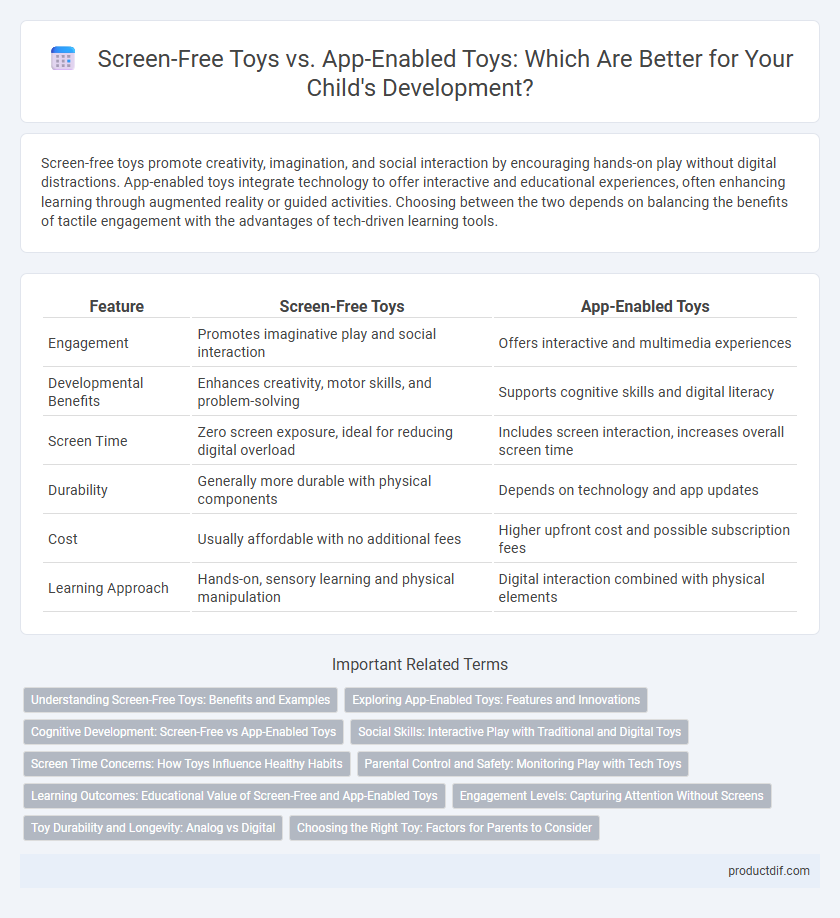Screen-free toys promote creativity, imagination, and social interaction by encouraging hands-on play without digital distractions. App-enabled toys integrate technology to offer interactive and educational experiences, often enhancing learning through augmented reality or guided activities. Choosing between the two depends on balancing the benefits of tactile engagement with the advantages of tech-driven learning tools.
Table of Comparison
| Feature | Screen-Free Toys | App-Enabled Toys |
|---|---|---|
| Engagement | Promotes imaginative play and social interaction | Offers interactive and multimedia experiences |
| Developmental Benefits | Enhances creativity, motor skills, and problem-solving | Supports cognitive skills and digital literacy |
| Screen Time | Zero screen exposure, ideal for reducing digital overload | Includes screen interaction, increases overall screen time |
| Durability | Generally more durable with physical components | Depends on technology and app updates |
| Cost | Usually affordable with no additional fees | Higher upfront cost and possible subscription fees |
| Learning Approach | Hands-on, sensory learning and physical manipulation | Digital interaction combined with physical elements |
Understanding Screen-Free Toys: Benefits and Examples
Screen-free toys encourage imaginative play and enhance cognitive development by eliminating digital distractions, fostering creativity and social interaction. Examples include classic building blocks, wooden puzzles, and board games that promote hands-on learning and fine motor skills. These toys support emotional well-being by reducing screen time and encouraging active, engaged play in children.
Exploring App-Enabled Toys: Features and Innovations
App-enabled toys integrate interactive digital elements that enhance learning through augmented reality, motion sensors, and voice recognition, fostering creativity and problem-solving skills. These toys often include customizable content and real-time feedback, which adapt to a child's developmental stage and interests, promoting personalized engagement. Innovations such as AI-driven storytelling and coding interfaces enable children to actively participate in the play experience while developing critical STEM competencies.
Cognitive Development: Screen-Free vs App-Enabled Toys
Screen-free toys such as building blocks and puzzles stimulate cognitive development by encouraging hands-on problem-solving and fostering creativity through tactile engagement. In contrast, app-enabled toys offer interactive learning experiences with adaptive challenges and immediate feedback, enhancing skills like memory, attention, and language through digital stimulation. Balancing both types can optimize cognitive growth by combining physical manipulation with technology-based cognitive exercises.
Social Skills: Interactive Play with Traditional and Digital Toys
Screen-free toys, such as building blocks and board games, promote face-to-face interaction, helping children develop essential social skills like communication, cooperation, and empathy. App-enabled toys offer interactive features that can enhance learning but often limit direct human interaction, potentially reducing opportunities for practicing social cues and turn-taking. Combining traditional play with selective digital engagement supports balanced social development by fostering both hands-on collaboration and tech-savvy problem-solving skills.
Screen Time Concerns: How Toys Influence Healthy Habits
Screen-free toys promote physical activity, creativity, and social interaction, reducing the risk of excessive screen time and associated health issues like eye strain and sleep disruption. App-enabled toys often combine digital engagement with educational content, but prolonged exposure can increase screen addiction and limit physical play. Balancing screen-free and app-enabled toys helps cultivate healthy habits, encouraging interactive play while managing digital device usage.
Parental Control and Safety: Monitoring Play with Tech Toys
Screen-free toys offer parents complete control over their child's play environment by eliminating digital risks and ensuring safe, tactile engagement. App-enabled toys integrate advanced parental control features such as usage time limits, content filters, and activity monitoring, allowing real-time supervision through connected devices. Both options emphasize safety, with tech toys providing transparency and customizable settings to protect children from inappropriate content and excessive screen time.
Learning Outcomes: Educational Value of Screen-Free and App-Enabled Toys
Screen-free toys foster hands-on learning, enhancing creativity, fine motor skills, and social interaction through tactile engagement and imaginative play. App-enabled toys integrate digital interactivity, offering personalized learning experiences, immediate feedback, and adaptive challenges that support cognitive development and problem-solving abilities. Both toy types contribute to educational value by addressing different aspects of child development, with screen-free toys emphasizing sensory and social growth and app-enabled toys enhancing technological literacy and digital skills.
Engagement Levels: Capturing Attention Without Screens
Screen-free toys foster higher engagement levels by encouraging imaginative play, physical activity, and social interaction, which stimulate cognitive and emotional development without digital distractions. App-enabled toys blend digital and physical play but can sometimes reduce sustained focus as children switch between screens and hands-on activities. Traditional toys like building blocks, puzzles, and board games often maintain children's attention longer, promoting creativity and problem-solving skills more effectively than screen-based alternatives.
Toy Durability and Longevity: Analog vs Digital
Screen-free toys, often made from durable materials like wood and high-quality plastics, tend to have longer lifespans due to their simple construction and lack of electronic components prone to failure. Analog toys withstand rough play and environmental wear better than digital toys, which may suffer from battery degradation, screen damage, or software obsolescence. The longevity of screen-free toys offers sustainable value and encourages imaginative play without the need for constant updates or replacements.
Choosing the Right Toy: Factors for Parents to Consider
Screen-free toys foster creativity and imaginative play, promoting children's cognitive and social development without digital distractions. App-enabled toys offer interactive learning experiences and personalized feedback, supporting skills in technology and problem-solving. Parents should consider their child's developmental needs, screen time limits, and the balance between physical and digital engagement when choosing the right toy.
Screen-free toys vs app-enabled toys Infographic

 productdif.com
productdif.com